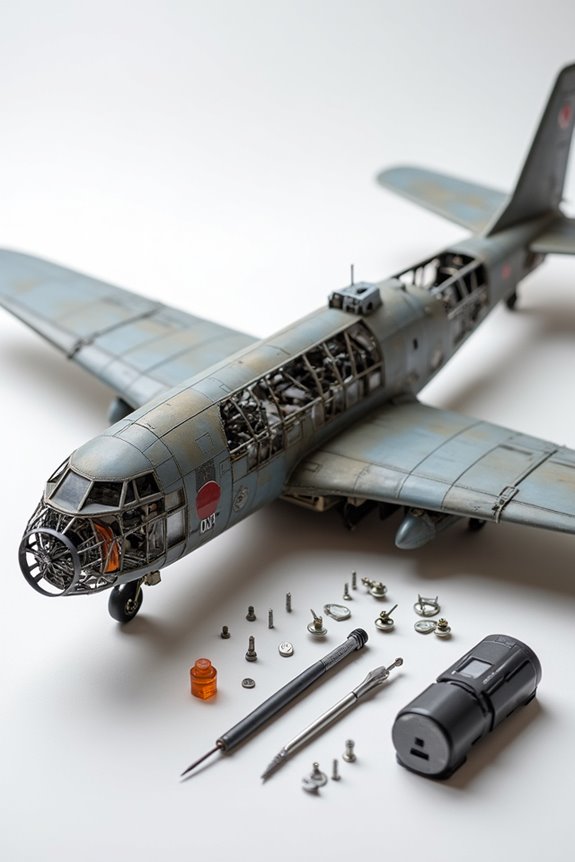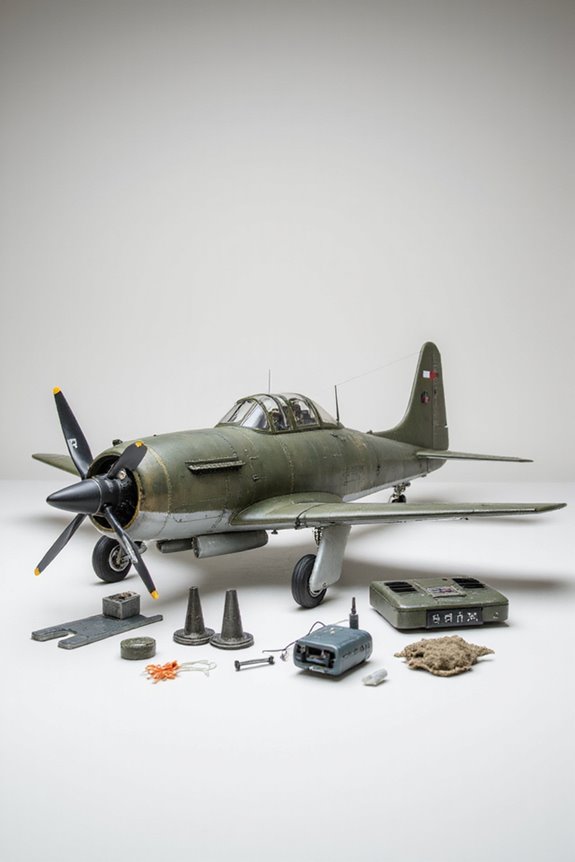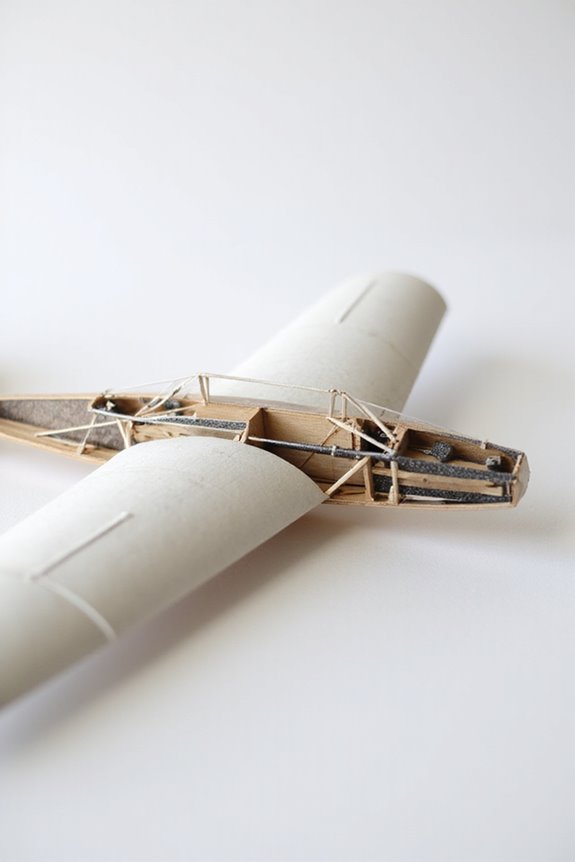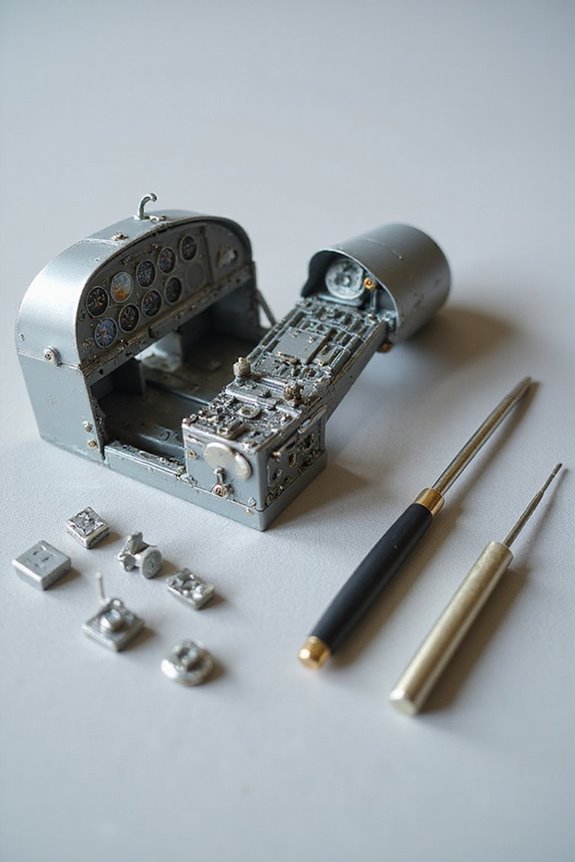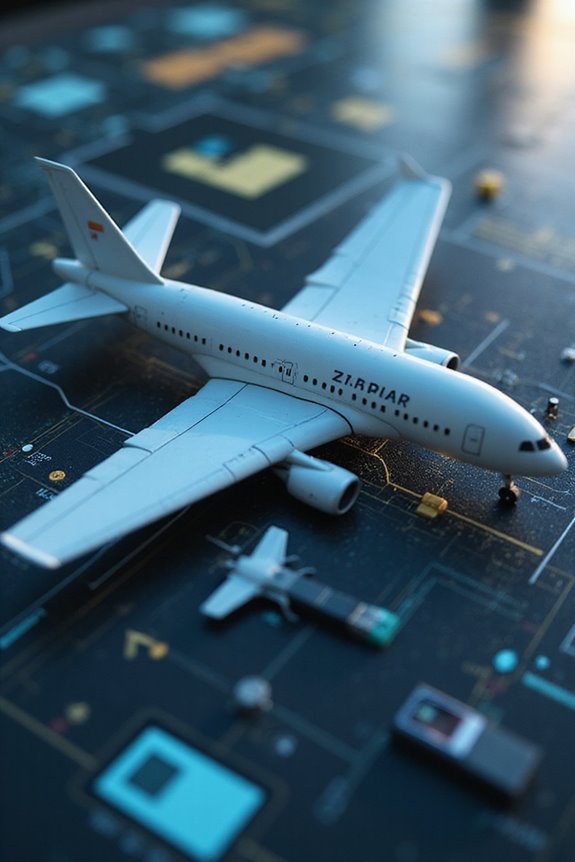Building an RC airplane kit can take anywhere from a few hours to nearly a year, depending on the kit’s complexity and our experience. For instance, simple foamboard kits might only take an afternoon, while advanced models could require months or even a year to perfect. Factors like our motivation, workspace organization, and builder experience play huge roles in the timeline. If you’re curious about tips for efficient building and costs, there’s more to explore!
Key Takeaways
- Build time varies widely: entry-level kits take 2 weeks to 1 month, while advanced kits may take up to a year.
- Complexity of the airframe design significantly affects the duration of assembly.
- Experienced builders can assemble simple wooden kits in just a few days.
- Builder motivation and experience level influence how quickly the assembly progresses.
- Regular building sessions and a tidy workspace enhance efficiency and maintain momentum.
Understanding Build Time Ranges for Different Kits
When we plunge into the world of RC airplane kits, it’s easy to feel overwhelmed by the range of options. Let’s break it down. Entry-level kits can usually be built in about two weeks to a month. For those with some builder experience, you might whip up a simple wooden kit in just a few days—or at least feel like a superhero! Intermediate kits, however, demand more patience. They can take several weeks or even months. The build complexity increases, and you might find yourself reading instructions more than you’d like. Advanced kits? Well, they’re for the committed. Some take up to a year due to meticulous detailing and special techniques. So, pick your kit wisely! It’s a journey, not a race. Additionally, it’s important to consider age appropriateness when selecting a kit, as it can significantly impact the build time and overall experience.
Factors Influencing Build Duration
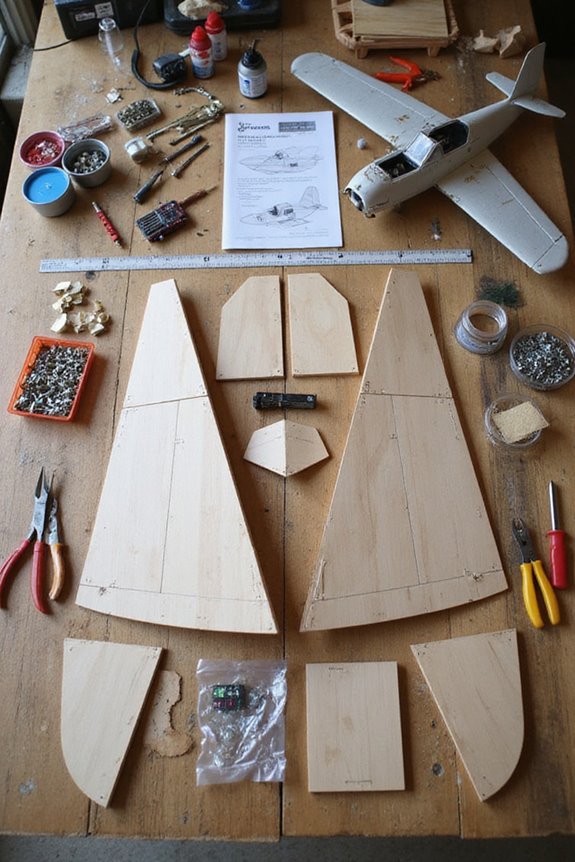
Building an RC airplane isn’t just about following the instructions; it’s influenced by several important factors that can really impact how long the build takes. For starters, the complexity of the airframe design can drastically affect our timeline. Intricate models require much more attention than simple trainers. Builder motivation plays a big role, too. If we’re excited, assembly techniques flow smoother and faster!
Our experience also counts. Beginners tend to take longer as they grapple with new skills. Meanwhile, having a tidy workspace with the right tools can speed things up—think of it as having a clear runway! Finally, managing our time wisely with regular building sessions can help us keep momentum and avoid those dreaded marathon builds. Additionally, the availability of comprehensive support resources can significantly enhance the building experience and efficiency.
The Role of Electronics in Assembly
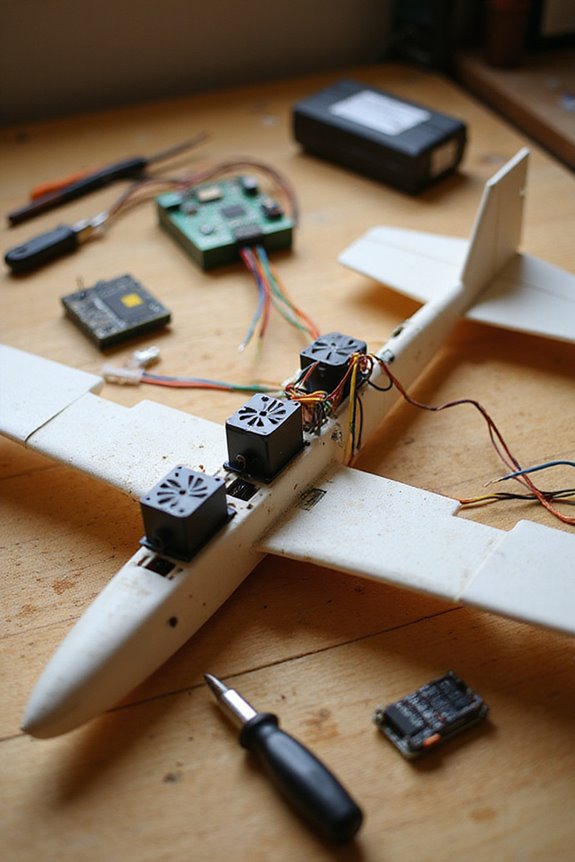
As we immerse ourselves in the heart of our RC airplane assembly, it’s clear that electronics play an essential role in getting things up and flying smoothly. Choosing the right electronics selection is critical, as mismatched components can result in non-functional controls. We’ve got ESCs, servos, and receivers to evaluate, so pay close attention to compatibility! Additionally, selecting servos with suitable torque ratings ensures optimal performance and control for your RC plane.
Wiring organization matters too. Neat routing isn’t just for aesthetics; it prevents interference and makes troubleshooting a breeze. Don’t be that person struggling with tangled wires mid-flight! And remember, quality is key—investing in reputable brands keeps our planes reliably soaring instead of crash-landed. Let’s commit to getting our electronics setup right, and we’ll enjoy many successful flights!
Examples of Quick Assembly Kits
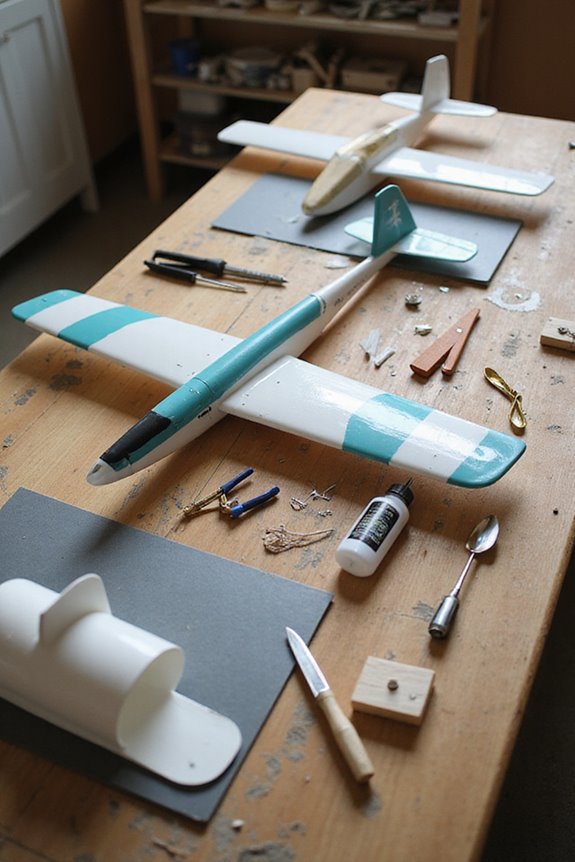
There are so many quick assembly kits for RC airplanes that anyone can jump into the hobby without feeling overwhelmed! Foamboard kits are perfect for those who want an afternoon project. With straightforward cutting and gluing, we can throw together a plane in just a few hours.
Then there are snap together models, which are like building with oversized Legos! These modular designs lock parts together, drastically reducing build time. They attract both beginners and seasoned builders who want a stress-free assembly experience without the fuss of complex fitting.
For instant gratification, ready-to-fly models require minimal setup and get us flying in under an hour. Additionally, age appropriateness ensures that the chosen kit matches the skill level of the builder, enhancing safety and enjoyment. So let’s dig in and build one of these fantastic kits today!
Cost and Material Considerations
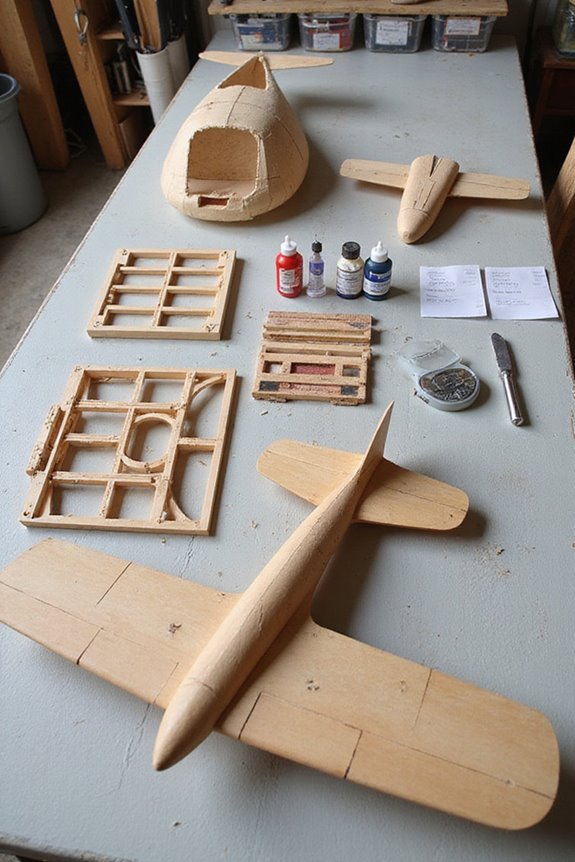
After whipping together one of those quick assembly kits, the next thing on our minds is cost and material considerations. The cost breakdown can get tricky, ranging from $100 to over $300 for a plane, depending on your material choices. Foam is great for beginners, offering durability and savings, while balsa wood’s classic appeal can lighten wallets a bit more.
Don’t forget the costs of transmitters, batteries, and essential tools—it adds up fast! A decent transmitter can set us back $60 to $300. Plus, quality materials truly impact performance. Higher-end options like carbon fiber boost functionality but also boost the bill. So, let’s budget wisely to keep our fun in the hobby, not bleeding our pockets dry. Additionally, using the right nitro percentage for your fuel can significantly enhance engine performance and longevity.
Typical Build Phases and Their Time Allocation
When we immerse ourselves in building an RC airplane kit, it’s important to know what to expect during each phase. First up is planning and preparation, which might take 2–4 hours but is worth every minute. We often wish we could fast-forward through this part, but organizing our parts upfront saves hunting time later.
Next, structure assembly can vary. Entry-level kits might take about a week, while complex ones can stretch into months. After framing, we tackle surface covering, which could take an extra week. Don’t forget the electrics! Integrating them usually means an intense weekend.
Finally, during final assembly and testing, expect another 5-10 hours before we’re ready to take to the skies. It’s also essential to consider that build complexity can greatly affect the total time required. Exciting, right?
Tips for Efficient Building and Time Management
To get the most out of our RC airplane kit building experience, we should focus on both efficiency and time management from the start. First, let’s keep tool organization in mind. A tidy workspace prevents us from turning into treasure hunters while searching for a craft knife. Trust me, it can feel like looking for a needle in a haystack!
Next, planning our part modification ahead of time makes a big difference. We can map out cutting sequences and identify components that need tweaking. By breaking the project into smaller sections, we’ll tackle each phase with confidence. Remember, multitasking is our friend too; let’s start assembling electronics while glue dries! With these tips, we’ll fly through the build without getting lost in the details.
Frequently Asked Questions
What Tools Are Necessary for Building an RC Airplane Kit?
When we think about what tools are necessary for building an RC airplane kit, we need essential equipment like cutting tools, assembly tools, and electronics installation tools to guarantee precision and a successful build.
How Does Weather Affect My Building Timeline?
It is understood that weather conditions can greatly impact our building timeline. High humidity or low temperatures lead to building delays, while extreme heat or moisture can damage materials, making it essential to adapt our workspace accordingly.
Can I Modify a Kit for Faster Assembly?
We’re all about those wild modification techniques—who doesn’t love assembly shortcuts? But remember, hurrying can lead to a less satisfying result. Let’s find that sweet spot between speed and craftsmanship—enjoy the journey!
What Maintenance Is Required Post-Build?
After we complete our builds, routine upkeep’s essential. Regular post-build inspections help us catch potential issues early, ensuring our RC airplanes stay in top shape and perform reliably throughout their flying adventures.
Are There Online Resources for Building Assistance?
Like finding gold in a field, we’ll uncover a treasure trove of building tutorials and forum discussions. Together, we can explore rich insights from experienced builders to navigate every twist and turn of our RC airplane journey.

